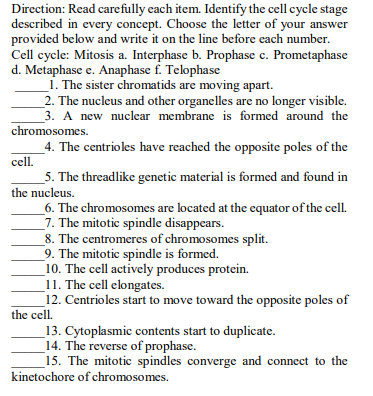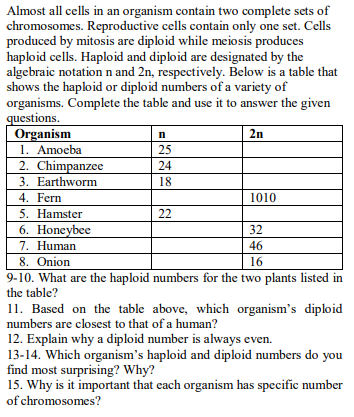Human Heredity: Principles and Issues (MindTap Course List)
11th Edition
ISBN:9781305251052
Author:Michael Cummings
Publisher:Michael Cummings
Chapter2: Cells And Cell Division
Section: Chapter Questions
Problem 21QP: Which of the following statements is not true in comparing mitosis and meiosis? a. Twice the number...
Related questions
Question

Transcribed Image Text:Direction: Read carefully cach item. Identify the cell cycle stage
described in every concept. Choose the letter of your answer
provided below and write it on the line before each number.
Cell cycle: Mitosis a. Interphase b. Prophase c. Prometaphase
d. Metaphase e. Anaphase f. Telophase
1. The sister chromatids are moving apart.
_2. The nucleus and other organelles are no longer visible.
3. A new nuclear membrane is formed around the
chromosomes.
_4. The centrioles have reached the opposite poles of the
cell.
5. The threadlike genetic material is formed and found in
the nucleus.
_6. The chromosomes are located at the equator of the cell.
7. The mitotic spindle disappears.
_8. The centromeres of chromosomes split.
9. The mitotic spindle is formed.
10. The cell actively produces protein.
_11. The cell elongates.
12. Centrioles start to move toward the opposite poles of
the cell.
_13. Cytoplasmic contents start to duplicate.
14. The reverse of prophase.
_15. The mitotic spindles converge and connect to the
kinetochore of chromosomes.

Transcribed Image Text:Almost all cells in an organism contain two complete sets of
chromosomes. Reproductive cells contain only one set. Cells
produced by mitosis are diploid while meiosis produces
haploid cells. Haploid and diploid are designated by the
algebraic notation n and 2n, respectively. Below is a table that
shows the haploid or diploid numbers of a variety of
organisms. Complete the table and use it to answer the given
questions.
Organism
1. Amoeba
2. Chimpanzee
3. Earthworm
4. Fern
5. Hamster
6. Honeybee
7. Human
8. Onion
9-10. What are the haploid numbers for the two plants listed in
n
2n
25
24
18
1010
22
32
46
16
the table?
11. Based on the table above, which organism's diploid
numbers are closest to that of a human?
12. Explain why a diploid number is always even.
13-14. Which organism's haploid and diploid numbers do you
find most surprising? Why?
15. Why is it important that each organism has specific number
of chromosomes?
Expert Solution
This question has been solved!
Explore an expertly crafted, step-by-step solution for a thorough understanding of key concepts.
This is a popular solution!
Trending now
This is a popular solution!
Step by step
Solved in 2 steps

Knowledge Booster
Learn more about
Need a deep-dive on the concept behind this application? Look no further. Learn more about this topic, biology and related others by exploring similar questions and additional content below.Recommended textbooks for you

Human Heredity: Principles and Issues (MindTap Co…
Biology
ISBN:
9781305251052
Author:
Michael Cummings
Publisher:
Cengage Learning

Human Physiology: From Cells to Systems (MindTap …
Biology
ISBN:
9781285866932
Author:
Lauralee Sherwood
Publisher:
Cengage Learning

Biology Today and Tomorrow without Physiology (Mi…
Biology
ISBN:
9781305117396
Author:
Cecie Starr, Christine Evers, Lisa Starr
Publisher:
Cengage Learning

Human Heredity: Principles and Issues (MindTap Co…
Biology
ISBN:
9781305251052
Author:
Michael Cummings
Publisher:
Cengage Learning

Human Physiology: From Cells to Systems (MindTap …
Biology
ISBN:
9781285866932
Author:
Lauralee Sherwood
Publisher:
Cengage Learning

Biology Today and Tomorrow without Physiology (Mi…
Biology
ISBN:
9781305117396
Author:
Cecie Starr, Christine Evers, Lisa Starr
Publisher:
Cengage Learning

Human Biology (MindTap Course List)
Biology
ISBN:
9781305112100
Author:
Cecie Starr, Beverly McMillan
Publisher:
Cengage Learning